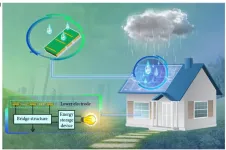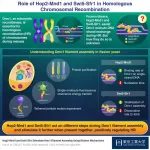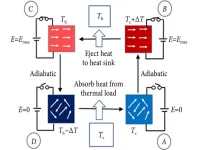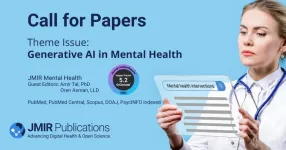(Press-News.org) When raindrops fall from the sky, they can produce a small amount of energy that can be harvested and turned into electricity. It is a small-scale version of hydropower, which uses the kinetic energy of moving water to produce electricity. Researchers have proposed that the energy collected from raindrops could be a potential source of clean, renewable power. However, this technology has been difficult to develop on a large scale, which has limited its practical application.
To collect raindrop energy, a device called a triboelectric nanogenerator (TENG), which uses liquid-solid contact electrification, has been shown to successfully harvest the electricity from raindrops. This technology also successfully harvests energy from waves and other forms of liquid-solid triboelectric power generation. However, droplet-based TENG (D-TENGs) have a technical limitation from connecting more than one of these panels together, which reduces overall power output. A recently published paper outlines how modeling D-TENG panels after solar panel arrays makes harvesting raindrop energy more efficient, broadening its application.
The paper was published in iEnergy on June 29.
“Although D-TENGs have ultra-high instantaneous output power, it is still difficult for a single D-TENG to continuously supply power for megawatt-level electrical equipment. Therefore, it is very important to realize the simultaneous utilization of multiple D-TENGs,” said Zong Li, a professor at the Tsinghua Shenzhen International Graduate School at Tsinghua University in Shenzhen, China. “Referring to the design of solar panels in which multiple solar power generation units are connected in parallel to supply the load, we are proposing a simple and effective method for raindrop energy harvesting.”
When multiple D-TENGs are connected, there is unintended coupling capacitance between the panels’ upper electrode and lower electrode. This unintended coupling capacitance reduces the power output of the D-TENG arrays. To reduce the effect of this problem, researchers proposed bridge array generators, which use array lower electrodes to reduce the influence of the capacitance.
When raindrops fall on the surface of the panel, a process called triboelectrification produces and stores the energy from the rain. When the droplet falls on the surface of the panel, called the FEP surface, the droplet becomes positively charged, and the FEP surface negatively charged. “The amount of charge generated by each droplet is small and the surface charge on the FEP will gradually dissipate. After a long time on the surface, the charges on the FEP surface will gradually accumulate to saturation,” said Li. “At this point, the dissipation rate of the FEP’s surface charge is balanced with the amount of charge generated by each impact of the droplet.”
In order to demonstrate the success of the bridge array generators with the array lower electrodes, the conventional D-TENG was compared to the bridge array generators. Researchers also compared the performance of the bridge array generators with different sizes of sub-electrodes. The thickness of the panels was also studied to see if that had an effect on any power loss. Increasing the FEP surface thickness lead to decreased coupling capacitance while maintaining the surface charge density, both of which could improve the performance of the bridge array generator.
When bridge array generators were developed for raindrop energy collection and utilized array lower electrodes and bridge reflux structures, the raindrop collection panels could be independent of each other. This means that unintended power loss could be reduced. “The peak power output of the bridge array generators is nearly 5 times higher than that of the conventional large-area raindrop energy with the same size, reaching 200 watts per square meter, which fully shows its advantages in large-area raindrop energy harvesting. The results of this study will provide a feasible scheme for large-area raindrop energy harvesting,” said Li.
Other contributors include Bin Cao and Liming Wang of the Tsinghua Shenzhen International Graduate School at Tsinghua University; Zhonghao Zhang of the China Electric Power Research Institute in Beijing; and Zhong Lin Wang of the Beijing Institute of Nanoenergy and Nanosystems at the Chinese Academy of Sciences in Beijing.
The National Natural Science Foundation of China (52007095) funded this research.
##
About iEnergy
iEnergy (Published by Tsinghua University Press), has multiple meanings, intelligent energy, innovation for energy, internet of energy, and electrical energy due to “i” is the symbol of current. iEnergy, publishing quarterly, is a cross disciplinary journal aimed at disseminating frontiers of technologies and solutions of power and energy. The journal publishes original research on exploring all aspects of power and energy, including any kind of technologies and applications from power generation, transmission, distribution, to conversion, utilization, and storage. iEnergy provides a platform for delivering cutting-edge advancements of sciences and technologies for the future-generation power and energy systems.
About Tsinghua University Press
Established in 1980, belonging to Tsinghua University, Tsinghua University Press (TUP) is a leading comprehensive higher education and professional publisher in China. Committed to building a top-level global cultural brand, after 42 years of development, TUP has established an outstanding managerial system and enterprise structure, and delivered multimedia and multi-dimensional publications covering books, audio, video, electronic products, journals and digital publications. In addition, TUP actively carries out its strategic transformation from educational publishing to content development and service for teaching & learning and was named First-class National Publisher for achieving remarkable results.
END
Homologous recombination (HR) is an important process that plays multiple crucial roles during meiosis, a type of cell cycle dedicated to sexual reproduction. During HR, homologous DNA molecules exchange their genetic material. During the meiotic prophase, DNA are clipped throughout the genome, forming numerous DNA double-strand breaks. Such DNA breaks attract homologous recombination enzymes, which promote pairing of homologous chromosomes.
Dmc1 is one such meiosis-specific recombinase in eukaryotes (organisms that have a clearly defined nucleus), ...
Covalent organic frameworks (COFs) are versatile materials composed of interconnected organic molecules held together by covalent bonds. These frameworks can be constructed in two-dimensional or three-dimensional (3D) forms which possess a unique combination of low density, high surface area, and easily tunable properties. Among the various types of COFs, imine-linked COFs have garnered considerable attention owing to their exceptional thermal and chemical stability as well as their broad scope of monomeric starting materials.
However, traditional bulk synthetic methods for COFs often yield powders that are insoluble ...
As necessary as cooling technologies are, we’re still operating on an outdated technology that can be considered a significant contributor to global warming and greenhouse gas emissions. Currently, vapor compression cycle-based cooling (VCC) is the standard for reliable cooling of air conditioning and refrigeration, but by switching to electrocaloric cooling (EC) researchers are hoping to create a more environmentally friendly, scalable and compressor-free method of cooling to benefit businesses, families and the environment.
The researchers published their work in iEnergy on ...
(Toronto July 19, 2023) Fully open access publisher JMIR Publications has acquired the Online Journal of Public Health Informatics (OJPHI), expanding its portfolio to 35 gold open access journals. This acquisition marks an open access milestone in JMIR Publications’ continued mission to keep openness at the heart of what it does.
Indexed in PubMed Central, OJPHI has been delivering the latest developments in the emerging field of public health informatics since 2009. The journal publishes research articles, book reviews, technology reviews, working papers, interviews, commentaries, and handpicked student capstone projects.
All ...
JMIR Medical Education (2023 Impact Factor 5.2) and Guest Editors: Amir Tal, PhD, and Oren Asman, LLD welcome submissions to a special theme issue examining "Responsible Design, Integration, and Use of Generative AI in Mental Health"
This special theme issue aims to unite various stakeholders in exploring the responsible use of generative artificial intelligence (GAI) within the mental health domain. The goal is to curate a collection of articles that examine the advantages, challenges, and potential risks associated with deploying GAI models ...
Prof Sei-ichi Tsujimura of the Nagoya City University and Prof Su-Ling Yeh of National Taiwan University and Kagoshima University, have discovered that our visual acuity (contrast sensitivity) can be improved by using a light with a special spectrum that can selectively stimulate melanopsin cells in the retina.
Background
The retina of our eye contains cone photoreceptor cells, which identify colors in bright environment, and rod photoreceptor cells, which work in the dark. It has long been thought that humans see and identify objects by these two types of photoreceptor cells alone. ...
Intermittent rivers and ephemeral streams are the world's dominant river ecosystem, yet monitoring and management typically focus on rivers that flow year round. Writing in BioScience, Amélie Truchy of the French National Research Institute for Agriculture, Food, and the Environment (INRAE) and colleagues describe the problem, as well as a potential solution: citizen science.
The authors discuss the results from a new app, DRYRivERS, which allows scientist and nonscientist users alike to record data on ephemeral streams and intermittent ...
For millions of Americans who have heart surgery or experience cardiovascular complications, like heart attack or heart failure, they may be encouraged to participate in cardiac rehabilitation. The medically supervised program combines lifestyle changes, education and physical activity to help patients recover and reduce their risk of future problems.
A Michigan Medicine study now finds that people who participate in cardiac rehabilitation have a decreased risk of death years after surgery, with a trend towards better outcomes in patients who attend more sessions.
“Time and time again, cardiac rehabilitation has been shown to ...
As life expectancy increases worldwide, age-associated diseases such as osteoporosis are having an increasing impact. Although early detection could help physicians intervene as soon as possible — when treatment might offer the greatest benefit — this type of detection is not yet possible with current osteoporosis diagnostic tests. Now, researchers reporting in ACS Central Science have developed a biosensor that could someday help identify those most at risk for osteoporosis using less than a drop of blood.
Early intervention is critical to reducing the morbidity and mortality associated with osteoporosis, a condition characterized by an elevated ...
Whether enjoyed on its own or mixed into a latte, Americano or even a martini, espresso provides an ultra-concentrated jolt of caffeine to coffee lovers. But it might do more than just wake you up. Research now published in ACS’ Journal of Agricultural and Food Chemistry shows that, in preliminary in vitro laboratory tests, espresso compounds can inhibit tau protein aggregation — a process that is believed to be involved in the onset of Alzheimer’s disease.
Roughly half of all Americans drink coffee every day, and espresso is a popular way to consume ...







